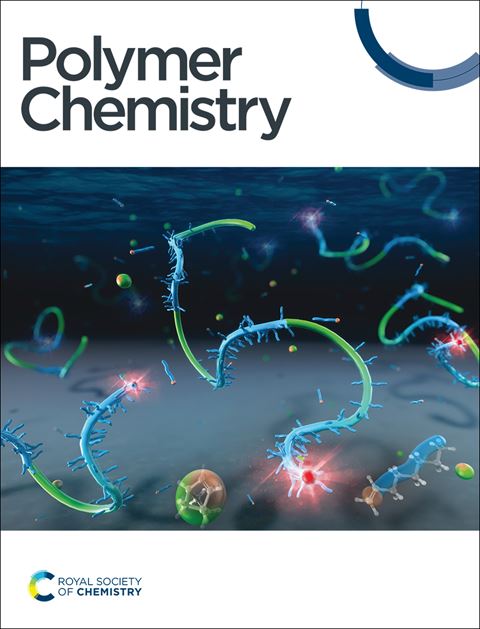具有催化性能的双或三金属组成的聚合物-金属纳米复合材料
IF 4.1
2区 化学
Q2 POLYMER SCIENCE
引用次数: 0
摘要
近年来,聚合物-金属纳米复合材料(pmnc)等杂化材料的多相催化性能越来越受到人们的关注,因为它们的物理化学性质与同类材料有很大的不同。制备pmnc的传统技术使用封盖/稳定剂包裹金属纳米颗粒(MNPs),形成屏障,限制活性位点的可用性,降低催化效率。本文提出了一种通过超声波处理原位制备金(Au)、钯(Pd)和银(Ag)基pmnc的方法,该方法将不受阻碍的MNPs附着在由可逆加成-破碎链转移(RAFT)聚合诱导自组装(RAFT- pisa)合成的聚合物链表面的胺官能团上。高分辨率透射电子显微镜(HR-TEM)成像和能量色散x射线(EDX)成像证实了这些pmnc的成功制备。对这些PMNC的催化性能进行了评价,如1-苯乙醇的好氧氧化反应和4-碘酚与苯硼酸的Suzuki-Miyaura交叉偶联反应,在0.02 mol%的浓度下,双金属Au-Pd PMNC和双金属Ag-Au PMNC的催化性能分别高达94%和98.5%。此外,在相同浓度下,三金属Ag-Au-Pd PMNC对两种反应的催化性能分别为39.8%和96.0%。这项工作旨在扩大pmnc的知识,并促进其作为有机反应中先进的多相催化剂的应用。本文章由计算机程序翻译,如有差异,请以英文原文为准。
Polymer–metal nanocomposites with bi- or tri-metallic compositions exhibiting catalytic properties†
The use of hybrid materials such as polymer–metal nanocomposites (PMNCs) in heterogeneous catalysis has rapidly gained attention in recent years due to their enhanced catalytic performance and significantly different physicochemical properties compared to their larger counterparts. Traditional techniques for preparing PMNCs involve the use of capping/stabilising agents that wrap around metal nanoparticles (MNPs), forming a barrier that limits active site availability and reduces catalytic efficiency. This paper presents an approach for preparing gold (Au), palladium (Pd) and silver (Ag)-based PMNCs in situ via ultrasonic treatment with unobstructed MNPs attached to amine functionalities located on the surface of polymeric chains synthesised from reversible addition–fragmentation chain-transfer (RAFT) polymerisation-induced self-assembly (RAFT-PISA). High resolution transmission electron microscopy (HR-TEM) imaging and energy-dispersive X-ray (EDX) mapping confirmed the successful preparation of these PMNCs. The catalytic performances of these PMNCs are evaluated against well-known organic reactions such as the aerobic oxidation of 1-phenylethanol and the Suzuki–Miyaura cross-coupling reaction between 4-iodophenol and phenylboronic acid, where the performance of the bimetallic Au–Pd PMNC and the bimetallic Ag–Au PMNC reached as high as 94% and 98.5% for each respective reaction at a concentration of 0.02 mol%. Additionally, the catalytic performance of the trimetallic Ag–Au–Pd PMNC was discovered to be 39.8% and 96.0%, respectively, for both reactions at the same concentration. This work aims to expand the knowledge of PMNCs and promote their utility as advanced heterogeneous catalysts in organic reactions.
求助全文
通过发布文献求助,成功后即可免费获取论文全文。
去求助
来源期刊

Polymer Chemistry
POLYMER SCIENCE-
CiteScore
8.60
自引率
8.70%
发文量
535
审稿时长
1.7 months
期刊介绍:
Polymer Chemistry welcomes submissions in all areas of polymer science that have a strong focus on macromolecular chemistry. Manuscripts may cover a broad range of fields, yet no direct application focus is required.
 求助内容:
求助内容: 应助结果提醒方式:
应助结果提醒方式:


